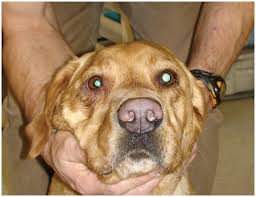By Dr Santosh Giri, Pet Consultant,Varanasi
Horner’s syndrome is a common neurological disorder of the eye and facial muscles. The condition usually occurs suddenly and typically affects one side of the head but can be bilateral (affect both sides of the head) in rare cases.
Horner’s syndrome is due to a dysfunction of the sympathetic nerves of the eyes and surrounding facial muscles. This is part of the autonomic nervous system, which helps to control normal functions such as blinking, muscle tone, etc.
“Horner’s syndrome is often classified as idiopathic, which means it is without known cause.”
There are many reasons for Horner’s syndrome. The dysfunction may be caused by damage to the sympathetic pathway as it runs through the neck or chest. This may be due to an injury such as a bite wound or blunt trauma, a tumor, or intervertebral disc disease. Middle or inner ear disease (otitis media or otitis interna) can also cause Horner’s syndrome. Other causes for an elevated or protruding third eyelid gland include: tetanus, facial nerve paralysis, facial muscle atrophy, and dehydration. However, Horner’s syndrome is often classified as idiopathic, which means it is without known cause.
The onset of Horner’s syndrome can be sudden and without warning. In some cases, the dog may have eye symptoms, as well as excessive salivation and/or difficulty eating on the affected side.
Any dog can develop Horner’s syndrome although Golden Retrievers and Collies have a somewhat higher incidence.
Causes of Horner’s Syndrome in Dogs————–
Horner’s syndrome in dogs occurs when a nerve going from the eye to the brain has been damaged. There are three things that can happen to cause the damage to the nerve. Central Lesion The nerve has been damaged somewhere before the nerve exits the spinal cord. Blood clots, spinal cord tumors, brain tumors or trauma can cause the damage in this location. Other neurological signs may present such as stumbling or head tilting. Preganglionic Lesion There has been nerve damage between the spinal cord and the synapse. Trauma to the neck or tumors in the neck or chest can cause the damage in this location. Postganglionic Lesion The nerve has been damaged between the synapse and the actual eye. This can occur when the ear is cleaned vigorously or the dog has middle ear disease. Most postganglionic lesions have an unknown cause.
The most common clinical signs of Horner’s syndrome are:————
• drooping of the upper eyelid on the affected side (ptosis)
• the pupil of the eye on the affected will be constricted (miosis)
• the eye on the affected side often appears sunken (enophthalmos)
• the third eyelid of the affected side may appear red and raised (prolapse of the third eyelid, conjunctival hyperemia)
•
Diagnosis of Horner’s Syndrome in Dogs ————-
Most veterinarians will diagnose Horner’s syndrome based on clinical symptoms. Once it has been diagnosed, however, it is important to find out where the interruption between the brain and the eye is occurring. This can be done by your veterinarian or you may be referred to a specialist. A phenylephrine solution eye drop will be put in both eyes of your dog. If the affected eye responds to the solution by resolving all clinical symptoms and appears normal, the damage is postganglionic. If the eye does not respond to the eye drops, additional diagnostic testing will be required. Chest x-rays, blood work, radiographs, pharmacological testing on the eye and an MRI are some of the testing that may be required to determine the location of the damage and set a treatment plan.
Treatment—————-
Most cases of Horner’s syndrome will resolve spontaneously; however, it is important to treat any underlying disease. There are several diagnostic tests that will be performed to determine if there is an underlying cause in your pet including an eye and ear exam, radiographs (X-rays) of the skull and chest, and possibly advanced imaging such at CT scans or MRIs. Pharmacologic tests may include phenylephrine drops placed in the affected eye to help localize the source of the problem.
If the lesion is not due to any pathological cause, a slow recovery lasting up to several weeks to 4 months can be expected.


